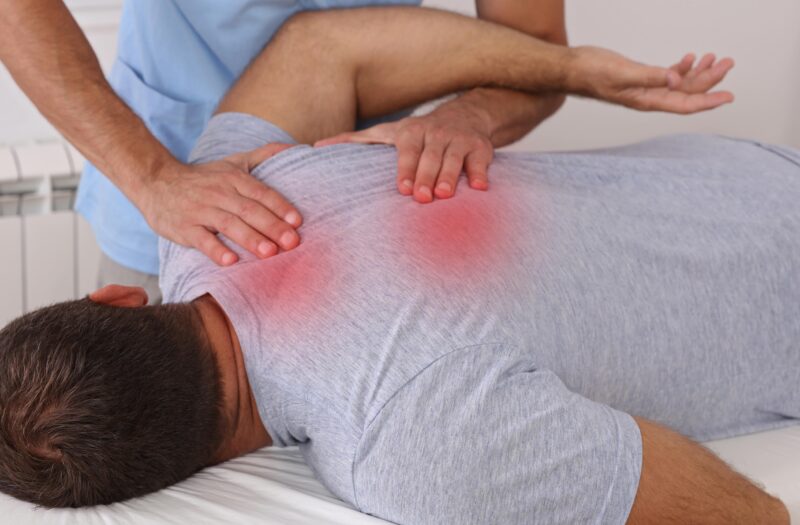Experiencing back pain can be a debilitating and frustrating condition, affecting our daily activities and overall quality of life. Amidst various treatment options, massage therapy often emerges as a popular choice. But the critical question remains: Can massage really help alleviate back pain? This blog explores the effectiveness of massage therapy in managing back pain, its benefits, and what to consider before starting treatment.
Understanding Back Pain:
Back pain can stem from various causes, including muscle strain, poor posture, underlying health conditions, or even stress. It’s essential to understand the cause of back pain to determine the most effective treatment.
The most common causes of back pain include:
- Muscle or Ligament Strain: Repeated heavy lifting or a sudden awkward movement can strain back muscles and spinal ligaments. Overactivity or poor posture can also lead to muscle strains or spasms.
- Bulging or Ruptured Discs: Discs act as cushions between the bones (vertebrae) in your spine. The soft material inside a disc can bulge or rupture and press on a nerve, leading to back pain. However, disc disease is often found incidentally; not all disc abnormalities cause pain.
- Arthritis: Osteoarthritis can affect the lower back. In some cases, arthritis in the spine can lead to a narrowing of the space around the spinal cord, a condition called spinal stenosis.
- Skeletal Irregularities: A condition in which your spine curves to the side (scoliosis) can lead to back pain, but generally only if the scoliosis is severe.
- Osteoporosis: Your spine’s vertebrae can develop compression fractures if your bones become porous and brittle.
- Poor Posture: Chronic poor posture while sitting or standing, especially when using computers or other devices, can lead to back pain over time.
- Injury or Trauma: Accidents, falls, or sports injuries can cause severe back pain, often due to injury to muscles, ligaments, or nerves.
- Stress and Tension: Emotional stress can lead to tension in the back muscles, which can result in pain or discomfort.
The Science Behind Massage Therapy:
Massage therapy involves manipulating the body’s soft tissues through various techniques to relieve pain, reduce stress, and promote relaxation. The science behind it suggests that massage can help by:
- Improving Blood Circulation: Enhanced circulation can aid in healing sore or stiff muscles, which are often sources of back pain.
- Reducing Tension: Massage helps in relaxing tense muscles and can alleviate the pain resulting from muscle tightness or spasms.
- Releasing Endorphins: These natural painkillers of the body can help in reducing pain perception.
- Improving Flexibility: Regular massage can improve flexibility and mobility, reducing the likelihood of future back pain.
Types of Massage for Back Pain:
Different types of massage techniques can be beneficial for back pain, including:
- Swedish Massage: Known for its gentle strokes and kneading motions, it’s ideal for releasing muscle tension and promoting relaxation.
- Deep Tissue Massage: Targets deeper layers of muscle and connective tissue, suitable for chronic back pain.
- Trigger Point Therapy: Focuses on specific areas of muscle tension, providing relief from pain points.
When to Consider Massage for Back Pain:
Massage therapy can be beneficial for several spinal conditions, particularly those involving muscle tension and soft tissue issues. However, it’s important to consult with a healthcare professional before seeking massage therapy for spinal conditions. Here are some spinal conditions where massage may be helpful:

- Muscle Tension and Strain: For conditions related to muscle tension, such as muscle strains or spasms in the back, massage can help relax and loosen the muscles, providing relief from pain and discomfort.
- Chronic Lower Back Pain: Massage can be effective in reducing chronic lower back pain, improving function, and decreasing the need for pain medication.
- Sciatica: This condition, characterized by pain that radiates along the sciatic nerve path, can sometimes be alleviated by massage therapy, particularly if the pain is due to muscle tension or spasms compressing the nerve.
- Scoliosis: While massage can’t correct the spinal curvature in scoliosis, it may help alleviate some of the discomfort and muscular pain associated with this condition.
- Osteoarthritis of the Spine: Massage can sometimes help in managing pain and stiffness associated with spinal osteoarthritis by improving circulation and reducing muscle tension.
- Fibromyalgia: Though not exclusively a spinal condition, fibromyalgia can cause significant back pain. Massage may help reduce the muscle pain and stiffness associated with this condition.
- Spinal Stenosis: For those with mild to moderate spinal stenosis, massage might help relieve some of the associated pain by relaxing the muscles and improving blood flow.
It’s essential to remember that massage therapy should be part of a comprehensive treatment plan and not the sole treatment for spinal conditions. Additionally, some spinal conditions, like acute injuries, severe osteoporosis, or spinal infections, may be contraindicated for massage. Therefore, it’s crucial to have a proper diagnosis and discuss with a healthcare provider whether massage therapy is suitable for your specific spinal condition.
When to Avoid Massage for Back Pain:
There are certain spinal conditions where massage therapy may be contraindicated, or at least require special consideration and modifications. It’s crucial for individuals with these conditions to consult with a healthcare provider before undergoing massage therapy. Here are some spinal conditions and situations where massage may be contraindicated:
- Acute Injuries: If there is an acute injury to the spine, such as a fracture, severe sprain, or dislocation, massage therapy should be avoided in the affected area until the injury has healed.
- Severe Osteoporosis: In cases of severe osteoporosis, the bones become fragile and brittle, increasing the risk of fractures. Deep or vigorous massage techniques could potentially cause harm.
- Spinal Infections: Conditions like osteomyelitis (infection of the bones), discitis (infection in the intervertebral disc space), or epidural abscesses contraindicate massage as it could exacerbate the condition.
- Spinal Tumors: If there are tumors in or around the spinal region, massage could potentially spread cancerous cells or exacerbate pain and discomfort.
- Cauda Equina Syndrome: This serious condition involves nerve root compression at the end of the spinal cord and requires immediate medical intervention. Massage could worsen the condition.
- Unstable Spinal Columns: Conditions like severe scoliosis or kyphosis, especially if they involve spinal instability, may be adversely affected by certain types of massage.
- Rheumatoid Arthritis in the Spine: While gentle massage may be beneficial for muscle pain, vigorous techniques might exacerbate joint pain or cause joint damage in people with rheumatoid arthritis affecting the spine.
- Recent Spine Surgery: Following spinal surgery, the affected area should not be massaged until it is fully healed and cleared by a healthcare professional.
- Certain Disc Issues: While massage can be beneficial for some disc-related problems, in cases of acute or severe herniated discs, especially if they are pressing on a nerve, massage may be contraindicated.
When dealing with any of these conditions, the decision to use massage therapy should be made in consultation with a healthcare provider who understands the individual’s specific spinal condition and overall health status. In some cases, alternative therapies or modified massage techniques may be more appropriate.
Conclusion:
Massage therapy can be a valuable tool in managing back pain, especially when combined with other treatments like physical therapy or exercise. However, it’s important to have realistic expectations and understand that massage may not be a cure-all. For best results, choose a licensed massage therapist and discuss your specific back pain issues with them. As part of a holistic approach to back health, massage therapy can offer significant relief and improve your quality of life.










